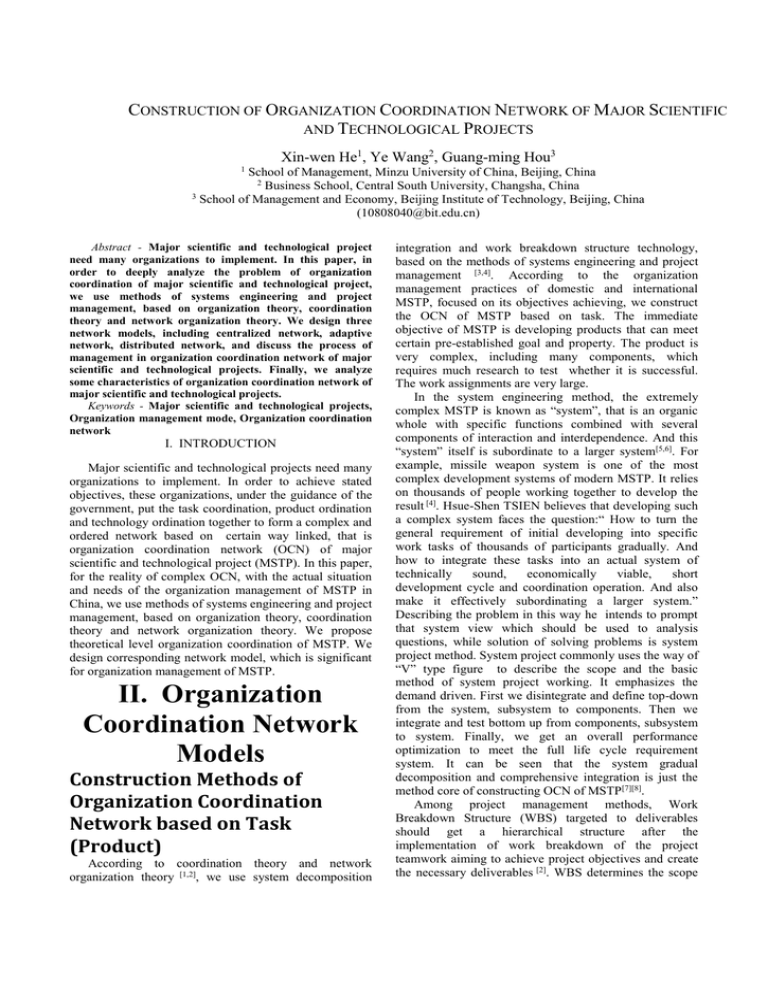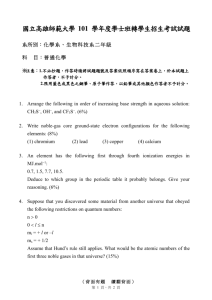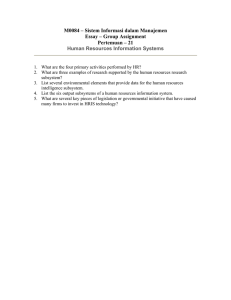Document 14407379
advertisement

CONSTRUCTION OF ORGANIZATION COORDINATION NETWORK OF MAJOR SCIENTIFIC
AND TECHNOLOGICAL PROJECTS
Xin-wen He1, Ye Wang2, Guang-ming Hou3
1
School of Management, Minzu University of China, Beijing, China
2
Business School, Central South University, Changsha, China
3
School of Management and Economy, Beijing Institute of Technology, Beijing, China
(10808040@bit.edu.cn)
Abstract - Major scientific and technological project
need many organizations to implement. In this paper, in
order to deeply analyze the problem of organization
coordination of major scientific and technological project,
we use methods of systems engineering and project
management, based on organization theory, coordination
theory and network organization theory. We design three
network models, including centralized network, adaptive
network, distributed network, and discuss the process of
management in organization coordination network of major
scientific and technological projects. Finally, we analyze
some characteristics of organization coordination network of
major scientific and technological projects.
Keywords - Major scientific and technological projects,
Organization management mode, Organization coordination
network
I. INTRODUCTION
Major scientific and technological projects need many
organizations to implement. In order to achieve stated
objectives, these organizations, under the guidance of the
government, put the task coordination, product ordination
and technology ordination together to form a complex and
ordered network based on certain way linked, that is
organization coordination network (OCN) of major
scientific and technological project (MSTP). In this paper,
for the reality of complex OCN, with the actual situation
and needs of the organization management of MSTP in
China, we use methods of systems engineering and project
management, based on organization theory, coordination
theory and network organization theory. We propose
theoretical level organization coordination of MSTP. We
design corresponding network model, which is significant
for organization management of MSTP.
II. Organization
Coordination Network
Models
Construction Methods of
Organization Coordination
Network based on Task
(Product)
According to coordination theory and network
organization theory [1,2], we use system decomposition
integration and work breakdown structure technology,
based on the methods of systems engineering and project
management [3,4]. According to the organization
management practices of domestic and international
MSTP, focused on its objectives achieving, we construct
the OCN of MSTP based on task. The immediate
objective of MSTP is developing products that can meet
certain pre-established goal and property. The product is
very complex, including many components, which
requires much research to test whether it is successful.
The work assignments are very large.
In the system engineering method, the extremely
complex MSTP is known as “system”, that is an organic
whole with specific functions combined with several
components of interaction and interdependence. And this
“system” itself is subordinate to a larger system[5,6]. For
example, missile weapon system is one of the most
complex development systems of modern MSTP. It relies
on thousands of people working together to develop the
result [4]. Hsue-Shen TSIEN believes that developing such
a complex system faces the question:“ How to turn the
general requirement of initial developing into specific
work tasks of thousands of participants gradually. And
how to integrate these tasks into an actual system of
technically
sound,
economically
viable,
short
development cycle and coordination operation. And also
make it effectively subordinating a larger system.”
Describing the problem in this way he intends to prompt
that system view which should be used to analysis
questions, while solution of solving problems is system
project method. System project commonly uses the way of
“V” type figure to describe the scope and the basic
method of system project working. It emphasizes the
demand driven. First we disintegrate and define top-down
from the system, subsystem to components. Then we
integrate and test bottom up from components, subsystem
to system. Finally, we get an overall performance
optimization to meet the full life cycle requirement
system. It can be seen that the system gradual
decomposition and comprehensive integration is just the
method core of constructing OCN of MSTP[7][8].
Among project management methods, Work
Breakdown Structure (WBS) targeted to deliverables
should get a hierarchical structure after the
implementation of work breakdown of the project
teamwork aiming to achieve project objectives and create
the necessary deliverables [2]. WBS determines the scope
of the project and organizes them together orderly. WBS
divides the project work into a number of small and
manageable tasks, each dropping meaning more detailed
description of the project work. In order to identify all the
tasks of completing project work, WBS (and vocabulary)
should divide the project needed completing according to
deliverables structure of project, life cycle phase of
project or use, into unit of work that is relatively
independent, content single and easy to manage. In the
US, according to management standards, any large
products should establish WBS system and work out
WBS dictionary, as the contact text to unified
management framework of the ordering party and the
contractor. It can be seen that WBS is the technology base
of OCN of MSTP[9].
Whether the system engineering “V” chart or the
project management WBS, they mainly describe the
whole tasks focused on product development. And each of
them is a hierarchical tree structure chart based on
breakdown of products, as shown in Fig. 1. Each level of
product breakdown structure diagram respectively
represents system, partial system, subsystem, components
and other development tasks. Focused on the need to
manage product development a production tasks services
to ensure the achievement, including integration and
assembly, test and evaluation, data management and
personal training, assurance facilities and equipment and
so on [10]. For different systems, the content of product
development task breakdown structure is different, but the
form is parallel. And the part of management security is
commonly used. Both the tasks of whole system design
breakdown integration and management security and the
tasks of each sub-item (often referred as work breakdown
or work package) after breakdown require one specific
unit (project team) in the organization of separate
implementation to undertake. Link relationship among
tasks determines the link of the collaborative of several
specific units within the implementing organization,
creating functional, project-based and matrix organization
structure models that can reflect the relationship between
project organization and functional department within
implementing organization. Besides, it also determines the
link relationship among a large number of implementing
organization, creating the basic structure models of OCN
of MSTP based on the whole WBS charter.
Sys tem
Partial System
Subsystem
Unit
Unit
Partial System
Subsystem
Unit
Subsystem
Unit
Unit
Subsystem
Unit
Unit
Unit
Fig.1. Simplified task decomposition structure model of
system
Model Construction of
Organization Coordination
Network
Just as a MSTP does not only have one feasible WBS
charter, the OCN of MSTP also has several structure
models, which depends on the hierarchical tree model of
WBS. And it is also affected by how many tasks taken on
by implementing organization, namely affected by the
number proportion of implementing organization of
different tasks taken on by different task hierarchy, and it
is also fundamentally constrained by the economic
institutional environment of MSTP. The basic models of
WBS can ensure that one task is only taken by one
implementing organization and one implementing
organization can take on several tasks. Under this
assumption, we will undertake the implementing
organization computing of different tasks across task-level
to calculation according to the implementing of the last
task-level. We consider several factors including the basic
model of the WBS, task level, task number, implementing
organization number of the same task-level, implementing
organization proportion of different task-level and
economic environment. We list three typical
representative distribution of different tasks and basic
models of OCN of MSTP under different economic
system as follows:
Centralized network. MSTP is integrated by whole
systems decomposition. Partial system and subsystem
development task are undertaken by a number of special
units of a implementing organization (referred to system
organizations). A small number of the bottom part
development task is undertaken by other implementing
organization (referred to component organization). MSTP
is star shaped centralization structure model which
regarded system organization as the core and component
organization as the edge, Fig. 2.
System
Partial System
U23
Partial System
U22
Subsystem
Subsystem
U1
Subsystem Subsystem
SystemOrganization
U21
Unit
Unit
Unit
Unit
Unit
Unit
……
Unit
Unit Organization
Unit
Fig.2. The simplified centralized model of OCN of
MSTP
Adaptive network. The whole system decomposition
integration task of MSTP is undertaken by an
implementing organization (referred to whole system
organization).Partial system development task is
undertaken by a large number of implementing
organization (referred to partial system). A large number
of subsystem development task is undertaken by few
implementing organization (referred to subsystem
organization). Numerous of bottom part development
task is undertaken by lots of implementing organization
(referred to component system). Thus the OCN of MSTP
manifests as adaptive structure model of level shape, Fig.
3.
U1
System
Partial System
Subsystem
Unit
Unit
Unit
U21
Partial System
Subsystem
single MSTP. Between the organizations by which several
MSTPs are carried out at the same time, there is no
complete continuous coordinated relationship. So, the
SystemOrganization
corresponding matrix structure is not within the scope of
Partial System
Organizationthis study.
Subsystem
Unit
Unit
U22
Unit
SubsystemOrganization
U31
Subsystem
Unit
Unit
U41
U42
U43
U44
Professional Financial
Logistics Se rvice
Company
Com pany
Othe rs
Unit Organization
Fig.3. The adaptive model of OCN of MSTP
Distributed network. The whole system decomposition
integration task of MSTP is undertaken by a
implementing organization. Every partial system
development task is undertaken by each professional
implementing organization. Each subsystem development
task is also undertaken by special implementing
organization. A large number of component development
task is undertaken by professional implementing
organization. Then the OCN of MSTP manifest as
distributed structure model of level shape, Fig. 4.
System
HR Company
MSTP 1
MSTP 2
Fig.5. Matrix structure of organization cluster.
OCU
UE
Ui
Ri1
Ri3
Ri2
LE
Ui1
Ui2
Ui3
SystemOrganization
U1
Fig.6. Basic structure unit diagram of OCN of MSTP
Partial System
Subsystem
Partial System
Subsystem
Subsystem
U21
U31
Subsystem
U32
U41 U42 U43 U44
Unit
Unit
Unit
Unit
Unit
Unit
Unit
Partial System Organization
U22
U33
U34
U45 U46 U47 U48
SubsystemOrganization
Unit Organization
Unit
Fig.4. The distributed model of OCN of MSTP
OCN models of MSTP mainly include the above
mentioned network models like centralized network,
adaptive network and distributed network. If the number
of implementary organizations, which have many tasklevels and undertake different work assignments in every
task-level, is equal, the OCNs of MSTP may show a
chain-type structure. Among varieties of open OCN
models of MSTP, the independent implementary
organization can not only undertake different work
assignments in the same task-level, it can also take on
tasks in different task-levels.(It would be better to
decrease the number of the organizations which take on
work assignment across multiple task-levels, or else the
developed semi-finished products would turnover
frequently and repeatedly among the implementary
organizations and the cost and time would increase.)
Between different organizations, there are not only formal
collaborative chained relationships, but also the informal
ones that do not aim at the MSTP. Between the various
implementary organizations, the target flow, task flow,
labor flow, product flow, capital flow, technology flow,
time flow and information flow will move vertically and
horizontally.
In addition, sometimes, several MSTPs are put into
effect simultaneously and a large number of implementary
organizations outsource the common management
services security business to professional service
organizations or companies partly. In the above conditions,
organization cluster shows a very complex matrix
structure. The brief model is shown in Fig. 5. This paper
analyzes the problem of organization coordination of
The Formal Quantitative Description of Organization
Coordination Network Model
Whether centralized network, adaptive network, or
distributed network, corresponding to levels type system
task of MSTP, between a level of implementary
organization and the next level, there is a monitoring and
coordinated relationship. This relationship can finally be
abstracted and shown in Fig. 6 which indicates the basic
structure. Thus, it realizes the OCN structure of unified
modeling. The OCN structure of MSTP is defined
uniformly and formally as follows:
OCU∷=(UE,LE,CR)
UE∷=Ui,i∈{1,2,…,e}
LE∷={Li |i∈{1,2,…,e1}}
Li∷=Uj ,i∈{1,2,…,e1},j∈{1,2,…,e}
CR∷={Ri |Ri: UE→Li,i∈{1,2,…,e1}}
Ui∷=Ei| Di,i∈{1,2,…,e}
Di∷={Ld |Ld∈Lj ,j∈{1,2,…,e1}},i∈{1,
2,…,e}
In the above equation, OCU is the double-level basic
structure set of OCN. UE is the upper implementary
organization of the basic structure set. LE is the lower
implementary organization of the basic structure set. CR
reflects the relationship between the two levels of the
implementary organization. Ei(i=0,1,…,e)means
the implementary organization. Di(i=0,1,…,e)is
the leadership decision-making group. Ui ( i = 0 ,
1 , … , e ) refers to the relatively independent
implementary organization. Ld means the main decision
people who are chosen from the lower implementary
organization. e refers to the total number of the implement
organization in the network. e1 is the total number of the
lower implement organization in the OCU.
After the uniform and formal definition of the OCN
structure of MSTP, we can build the tree structure of the
OCN. (In order to standardize, according to the principles,
we split the mesh structure form into a tree shape structure
form.) Shown in Fig. 7, the formal description of the
quantitative is as follows:
OCN∷=(UE,LE,CR)
UE∷=U
LE∷={L}
L∷=E| OCN
CR∷={R|R: UE→L}
U∷=E | D
D∷={Ld |Ld∈L}
Among the above equation, OCN is the built the OCN
structure. Other definitions are as above. Thus, according
to the above method, we can use these two kinds of basic
structure form to construct other OCN model recursively.
U1
U21
U31
U41
U42
P1
U22
U32
U43
U44
U33
U45
The Lif e Cycle of P roje ct
U34
U46
P2
U47
U48
P3
Fig.7. Structure diagram of OCN of MSTP
III. The characteristics
of organization
coordination network
Systematicness: One of the features of system is the
synergy of the subsystems, so that the overall effect is
greater than the sum of the various subsystems. System
approach is to determine and achieve the optimal target on
the basis of analyzing the data, information and objective
facts. Through system design and planning, to achieve
identified goals, we should form a complete solution
which includes the measures, steps and resources. During
the program implementation process, the system
management can improve the effectiveness. An
organization coordination network of MSTP is a
collaborative system. Interrelated processes will be
confirmed as a system to understand and manage. It may
help improve management efficiency and achieve the goal
of the project.
Coordination: Major scientific and technological
project itself is a system. Each implementation process
and different management process is also a system. In the
actual management process, we should analyze the
relationship between the work links overall and should
balance the various stakeholder interests adequately. We
had better give full consideration to the synergies between
various departments and implementary organizations, so
that Major scientific and technological project can
develop orderly, coordinately and efficiently.
Motivation: Implementary organization is the key
node of organization coordination network of MSTP. The
effective management about organization coordination
network of MSTP requires not only the highest organizers
of the correct orientation, but also depends on the whole
implementary organization's active participation. So, to
deal with implementary organization, we should take
effective incentives to stimulate the enthusiasm and social
responsibility of it. We need to focus on the strong
professional disciplines constitute of implementary
organization. Besides, we had better enhance the spiritual
and cultural refinement of MSTP. We should enhance the
enthusiasm and initiative of each implementary
organization so that the organization's energy can play out
fully and we can promote organization coordination
network's overall development.
Efficiency: There are many evaluation standards about
organization coordination network of MSTP. But the main
standard should be performance. If we want to build
organization coordination network of MSTP, we must
improve the efficiency. Besides, we may systematically
analyses and research various factors that affect the
development of organization coordination network of
MSTP. Through taking effective measures and methods,
we mobilize departments and implementary organization's
enthusiasm in many ways. By the strict and effective
construction of organization coordination network of
MSTP, we ensure the cooperation between the
implementary organizations so that the MSTP can be
carried on orderly and efficiently. We should improve the
efficiency of organization coordination network of MSTP
and finally realize the goals of MSTP.
IV. Conclusion
OCN are key elements of organization and
management of MSTP. Combined with the organization
and management practice, based on coordination theory
and network organization theory, we use methods of
systems engineering and project management. We
propose some principles to construct OCN of MSTP,
which are the same objectives, division of labor,
information communication and streamlining the upper.
We design three network models, including centralized
network, adaptive network, distributed network. Among
them, the task-based distributed network shows network
structure which is characterized by hierarchy and tree type
and it reflects the typical cross-organizational
coordination rules. OCN of MSTP has four characteristics:
systematicness, coordination, motivation and efficiency. It
has complex entity elements, inter-entity relationships,
network structure and management operation mode. So, it
requires an in-depth systematic research.
Acknowledgment
This work was supported by the National Natural
Science Foundation of P. R. China (No 71173016).
References
[1]
Haken , Synergetics , Xi’an: Northwestern University
Press,1981.
[2]
[3]
[4]
[5]
[6]
Powell, W. W., Neither marks nor hierarchy: network
forms of organization, In B.M.Staw&L.L.Cummings,
Research in organization behavior.Greenwich,CT:JAI
Press.1990.
B.W.Chai, Social networks and organizations, Beijing:
Renmin University of China Press, 2007.
X. S. Qian,the System Engineering, Shanghai: Shanghai
Jiaotong University Press, 2007.
Y. L. Wang , the System Engineering, Beijing: Higher
Education Press, 2009.
Project Management Institute, Y. J. Lu, Y. Wang,A Guide
to the Project Managment Body of Knowledge, 3rd ed.,
Beijing: Electronics Industry Press, 2005.
Raymond E. Miles, Charles C.Snow, Cause of Failure in
Network
Organizations,
California
Management
Review.1992,34(4):54-72.
[8] W. A. Li, The network organization—the new trend of
organization development, Beijing: Economic Science
Press, 2003
[9] J. Hong, T. Ke, Complex Adaptive of Network
Organization, Chinese Journal of Management Science,
2004, 12:123-126.
[10] B. Z. Guo,“China Aerospace and System Engineering”,
China Ordnance Industry, pp.13, April 2003
[7]







